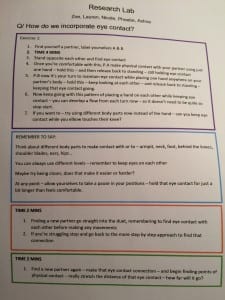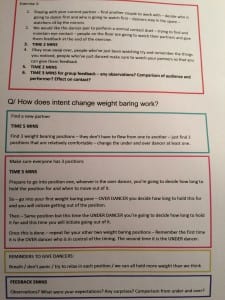Contact Research Labs – Structuring, investigating, performing and reflecting.
“I’m 75% confidant with Contact Improvisation”
I feel like 75 is a big number, like that’s only 25 away from being “100% confidant” – that feels daunting. I think if I allow myself to believe that I only feel 50% confident then if something goes wrong, or I have a bad day then it doesn’t really matter ‘because I’m not very good at contact’. I think allowing myself to say that I feel largely confidant with CI opens myself up to potential criticism like “I thought you said you were good”. Maybe this is a deep rooted insecurity that’s not specific to contact improvisation because realistically, with regards to my contact practice, there isn’t much that I don’t feel confidant with. Sure, I have an ongoing struggle with entering the space and following through with wanting to bring something into the improvisation, and I’m not great at taking my own weight into my hands (eg/ cannot do a handstand), and some times the fluidity of my movements is lacking but I think that all falls in the 25% that I’m yet to attain.
This week we read online articles by Daniel Lepkoff about Release Technique and Contact Improvisation. In What is Release Technique he discusses the relationship between intention and aesthetic, stating that “by the time an intention has been realised in a physical action, it is too late to alter how this action is played out” (Lepkoff, 1999). This is particularly prominent to us in our practice of CI, especially when we feel that it’s all going a bit wrong. It is so easy to watch footage or think about a session and pick out moments when we did something ‘ugly’ or a movement that was loud and awkward. But actually, those could have been moments where we were following our bodily intentions and listening to the sensations of those actions. I really don’t think it’s important what my practice looks like, maybe because my previous dance training didn’t have much emphasis on aesthetic I’m not that bothered, but I’d rather focus on moving with intention and feeling the sensation of connecting my head to my torso and following on with my legs. Personally I think CI looks the best when the dancers are absorbed in themselves and oblivious to what they’re doing with their bodies. But how do I get this quality into my choreographed duet?
Lepkoff also identifies an “underlying technique needed to prepare for and survive…contact improvisation” (Lepkoff, 2008) which I feel contradicts the purpose of CI and the universal appeal of it. Steve Paxton didn’t make CI with the intention of it becoming a technique, or for it to only be accessible to those who possessed a certain set of skills. Contact Improvisation was the name of an activity that anyone could do, where people would meet and throw themselves at each other, quite literally, to find new ways of using the body. However, the style of contact improvisation that I’m currently learning, and plain improvisation before that, has a strong composition element. How can I be improvising if I’m thinking about using the floor, varying my dynamics or making contact with someone? Obviously we need these reminders to allow us to learn to incorporate these elements without thinking, but where do we draw the line of using ‘strategies’ consciously and unconsciously? This is something I would like to explore further in our next research lab, as I think it would be beneficial to experiment with improvising with zero conscious thought.
For this weeks research lab my group presented exercises on strengthening eye contact and intentions within weight bearing work. We had done a practice run through of our tasks earlier in the week and had a mini feedback session between ourselves so that we knew what to expect as an outcome from the lab on Wednesday, however it was still intriguing to watch the class undertake our exercises (detailed in the pictures below).
With the eye contact exercise I watched some partners keep that connection easily, where as others would loose it and have to stop and find it again. I think the people that approached the task with a lot of focus and determination found it easier to keep their eyes on their partner, even when the movement really stretched their ability. Having experienced a similar exercise for another group’s lab, I know that being even a little bit distracted makes it so much harder to keep looking into someones eyes. In the feedback we gathered from the class it was pointed out that it was difficult to break and start anew with a different partner, that once they’d found a solid connection with a person they didn’t want to let that go. This wasn’t too surprising to hear as having done the exercise ourselves we understood the reluctance to leave a newly formed connection – but I think that having this established will help us as a class to stay in the jams, and stay dancing with one person for longer, because we’ll be wanting to exhaust the connection that we enter the space with. For me, I try not to leave a jam if I still have something to bring to it, when my mind goes blank is when I’ll usually retreat, but if I focus on finding strong connections with people then I think I can keep myself engaged for longer.
Our exercises on intention in weight bearing were the ones I was most excited to work on as the aim of the task was the most personal – I over think a lot during improvised weight bearing, and having a better understanding of the strength of my classmates would help to put my mind at ease, and hopefully our lab helped to do the same for everyone else. It was interesting that when we asked the class to find 3 positions, they all chose ones that stayed in their middle kinesphere and more detailed than the ones I’ve seen used in the Jams. Perhaps this is because they had time to play around with ideas, and in the jams you’re following your senses, which won’t always lead you into ‘interesting positions’ – which were mentioned in our feedback. A few dancers stated that they struggled to find ‘interesting positions’ – which wasn’t a requirement of the task, which leads me to think that we’re now looking to create that ‘aesthetic’ that Lepkoff was talking about, within our weight bearing poses(Lepkoff, 2008). Other things mentioned in our feedback session was that the over dancer’s exit strategy was effected by who was initiating the movement, which I think helped to identify ways to avoid habitual patterns; also the shape of the position played a big part in how long each dancer would hold it for; some structures put more strain on the under or over dancer, and so their partner wouldn’t hold it for too long as they were concerned about the well being of their friend.
I found all the research labs this week to be beneficial to my practice, as they proved to me that I was more capable than I thought I was, and that I’d been short changing some of my classmates, as they could take more weight than I had believed they could. My favorite task of the week was the ‘flying’ exercise from Yasmin’s group – I usually hate being lifted, but taking part in their lab was actually a lot of fun, and I hope we get to touch on that particular task again.
Lepkoff, D. (1999) What is Release Technique? Daniel Lepkoff. Available from http://www.daniellepkoff.com/Writings/What%20is%20Release.php. [Accessed 25/10/2015].
Lepkoff, D. (2008) Contact Improvisation: A Question? Daniel Lepkoff. Available from http://www.daniellepkoff.com/Writings/CI%20A%20question.php. [Accessed 25/10/2015].

